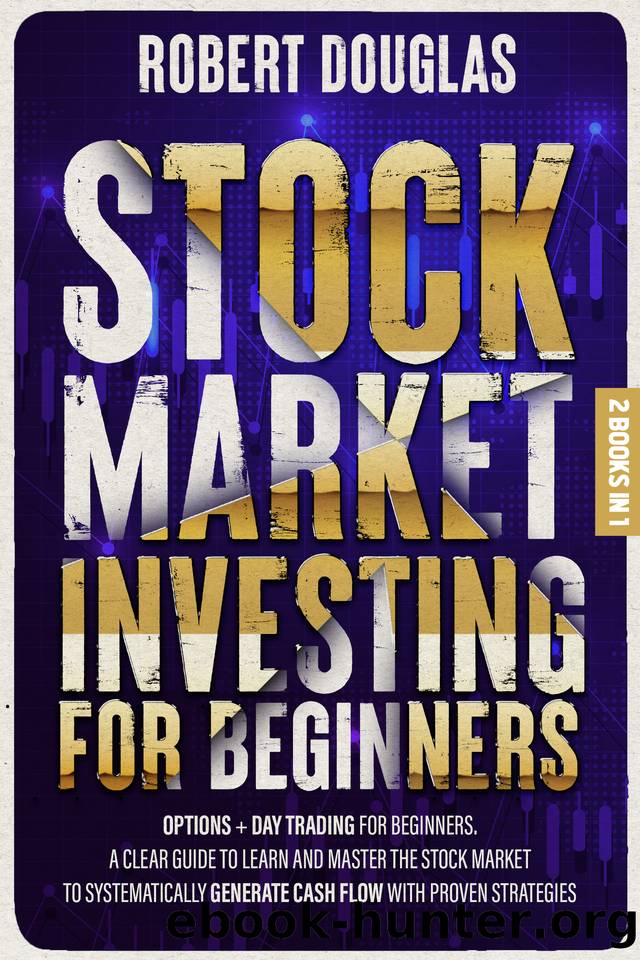Stock Market Investing for Beginners: 2 Books in 1: Options + Day Trading for Beginners. A Clear Guide to Learn and Master the Stock Market to Systematically Generate Cash Flow with Proven Strategies by Douglas Robert

Author:Douglas, Robert [Douglas, Robert]
Language: eng
Format: epub, mobi
Published: 2020-09-30T00:00:00+00:00
Introduction: Day Trading for Beginners
M any retail traders operate from a small home office. Others work in regular offices but remain small traders with limited funds but sufficient trading equipment. As a day trader, there is no boss or supervisor to tell a trader what to do. Nobody watches over them or bosses them around. This means a trader has the freedom to organize and manage their trading days.
Because of this freedom, day traders need to exercise a lot of discipline. Traders need to wake up early and prepare for the trading day. Mental preparation is part of a traderâs morning ritual before, during, or after breakfast. It is advisable to be up a couple of hours before the trading day begins and ensure everything is in place. There are a couple of things that generally need to be achieved.
1. As soon as breakfast is made, the trader should rehearse their strategies in their minds and probably on paper too. Sometimes it is necessary to run a strategy on a demo platform. Also, a good plan should be made and followed to the letter. This plan includes how much money to place on a trade, which points to exit a trade, when to take profits, and so on.
2. Traders need to check and confirm their trading accounts and the amounts therein. A trader must know the amount available for trading purposes so they know the amounts they can spend per trade. It is recommended that traders should not spend more than 2% of their trading capital on a single trade. The accepted range is between 1% and 2% of the account balance. Beginners with no prior trading experience should not spend more than 1% of their trading balance per trade. Also, a trader should exit their positions three minutes before a significant financial or economic announcement.
3. It is advisable to always or regularly check the financial calendar and note any significant events. Any such events should be marked onto the calendar and reminds initiated. These events have significant implications for stocks and activity at the markets.
Day traders must learn how to select the best stocks to trade. This is because the stocks chosen for day trading will pretty much determine the outcome of your trading ventures. As such, choosing the correct stocks ensures that you fare better at the markets and maximize on profitability.
Identifying Stocks for Day Trading
1. Funds Available
The first instance is to take cognizance of a traderâs financial position. Depending on the number of funds available, you can determine the stocks to choose. There is a wide variety of stocks to choose from. However, you can only choose as much as your funds allow you.
You also need to consider the amount of risk you can tolerate. Generally, the amount of risk a trader is willing to take the more they stand to win. Traders also need to consider buying a security in a field or industry that they are familiar with. For instance, an accountant may be happy trading financial stocks while an engineer will be at home with tech stocks, and so on.
Download
Stock Market Investing for Beginners: 2 Books in 1: Options + Day Trading for Beginners. A Clear Guide to Learn and Master the Stock Market to Systematically Generate Cash Flow with Proven Strategies by Douglas Robert.mobi
This site does not store any files on its server. We only index and link to content provided by other sites. Please contact the content providers to delete copyright contents if any and email us, we'll remove relevant links or contents immediately.
Rich Dad Poor Dad by Robert T. Kiyosaki(6186)
Pioneering Portfolio Management by David F. Swensen(6084)
How To Win Friends and Influence People by Dale Carnegie(4341)
The Money Culture by Michael Lewis(3851)
The Dhandho Investor by Mohnish Pabrai(3566)
The Wisdom of Finance by Mihir Desai(3532)
Liar's Poker by Michael Lewis(3229)
The Intelligent Investor by Benjamin Graham Jason Zweig(2937)
The ONE Thing by Gary Keller(2922)
Mastering Bitcoin: Programming the Open Blockchain by Andreas M. Antonopoulos(2895)
Fooled by Randomness: The Hidden Role of Chance in Life and in the Markets by Nassim Nicholas Taleb(2868)
Rich Dad Poor Dad: What The Rich Teach Their Kids About Money - That The Poor And Middle Class Do Not! by Robert T. Kiyosaki(2836)
Investing For Dummies by Eric Tyson(2800)
How to Win Friends and Influence People by Dale Carnegie(2799)
How to Day Trade for a Living: Tools, Tactics, Money Management, Discipline and Trading Psychology by Andrew Aziz(2787)
Market Wizards by Jack D. Schwager(2545)
Zero Hour by Harry S. Dent Jr. & Andrew Pancholi(2537)
How to Pay Zero Taxes, 2018 by Jeff A. Schnepper(2503)
Rich Dad's Guide to Investing by Robert T. Kiyosaki(2412)
